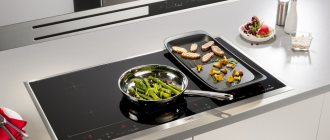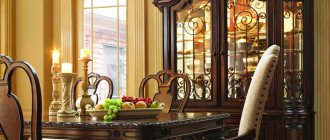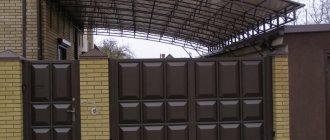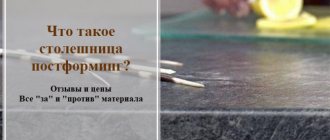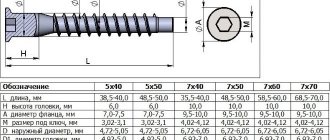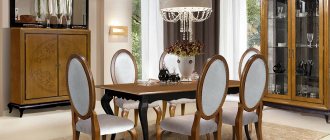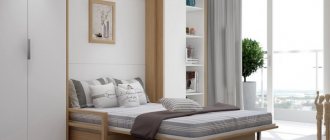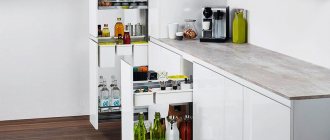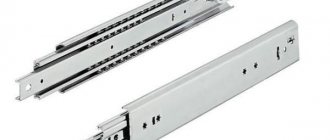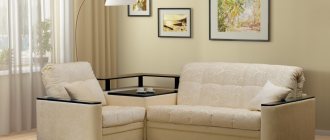The household appliances market is confidently filling up with glass-ceramic products. Each type of modern product has an original design and its own technical features. Useful tools make working in the kitchen easier. Not every cookware is suitable for a glass-ceramic stove. Pots and pans should have a bottom of a certain thickness and preferably a dark color for better heat absorption. For the panel to work as efficiently as possible, the diameter of the bottom of the cooking appliances must exactly match the size of the burner.
Features of glass-ceramic hob
The device operates on electricity without gas pipes. This makes it convenient and economical, allowing it to be placed anywhere in the room. The glass ceramic surface is smooth and perfectly flat. Heating zones are located in certain places, as indicated by contours of different diameters. Control is carried out using buttons on the touch panel.
The working elements of all electric models heat up instantly. The material of the glass-ceramic panel is ceran. It has high strength and the ability to withstand heavy objects. The burners on the panel can be of two types: halogen with heat-emitting lamps or High Light, heated by a ribbon made of a special alloy in the form of a snake.
The glass ceramic panel cools down as quickly as it heats up. It is safe to touch just a few minutes after switching off. For houses or apartments with frequent power outages, combined type models are suitable. There are electric and gas burners on the hob.
Characteristics of glass ceramic hob
This is a type of electric stove with a flat and smooth surface, made of a material called “ceran” - a combined mixture of ceramics and glass. The composition can withstand high temperatures and impacts from heavy objects, such as pots and pans.
Modern glass-ceramic panels have their own characteristics:
- Boiling. When the cookware reaches boiling point, the burner power is automatically reduced. An excellent feature that prevents borscht from escaping and the need to clean the surface after such a small disaster.
- Automatic control mode. The cooking product, its weight, the optimal temperature are the main parameters that are set on the display and allow you to save time. When everything is ready, the system beeps and stops working.
- Safety. To prevent accidental activation of the heating element, the lock mode is used. This is important if there are small children in the house.
- Heat. Modern glass-ceramic panels heat up only in the place where the dishes are placed. It is impossible to get burned by them. They provide uniform heating of the entire bottom and walls of dishes of different diameters.
- Availability of thermostats. They maintain the set temperature during cooking.
- Timer with auto shut off. The function can be activated on one burner or on several at once. Some stoves have a timer on all sides.
Hob types
Depending on the connection method, hobs can be autonomous or dependent on the heating element. All glass-ceramic models have high, easily adjustable thermal conductivity. The following types of hob surfaces are most commonly used:
- Electrical. They stand out for their huge functionality. When choosing such a model, you should take into account the large load on the electrical wiring. It must withstand high voltage. The hob is completely covered with a glass-ceramic hob. The burners are round or oval.
- Induction. Modern simple devices that are gradually replacing other types of surfaces. Practical, durable models equipped with advanced features. Economical equipment instantly heats the burner and automatically turns off if there are no containers on it.
- Gas. Reliable plates are able to work in the most extreme conditions. Modern glass-ceramic coating can withstand the effects of combustion and high temperatures on a par with metal surfaces.
Marking options
There must be a special sign (marking) on the accompanying label or on the bottom of the cookware for a glass-ceramic stove. If the stove has induction burners - the inscription Induction and a pictogram in the form of 5 turns of winding.
Other icons show on what type of heating element and on what surface a particular kitchen utensil can be used:
- halogen;
- ceramic;
- gas;
- electric.
If you have purchased a new ceramic stove with induction heaters, but there is no suitable cookware or there is very little of it, use a special adapter.
This is a convenient kitchen accessory made of ferromagnetic alloy with or without a removable handle. It allows you to cook on an induction glass-ceramic surface in any utensil you have in the kitchen.
Features of heating dishes
The burners of the glass-ceramic stove are heated by heating elements. The heat sources are located under the ceran plate that forms the base of the panel. The glass-ceramic coating has high thermal conductivity and resistance to mechanical damage. The cookware is heated using the following types of burners:
- Tape. The heating element is made of high resistance alloy. The tapes are tightly laid, which increases their heat transfer. 5-6 seconds are enough for complete heating.
- Rapid. They have the simplest design. Nichrome spirals heat up in 10 seconds. Round burners can be of different sizes. Electricity consumption depends on their size.
- Halogen. The heating element is represented by a quartz gas-filled tube. You can start cooking within 2 seconds after turning it on. The amount of electricity consumed is higher than other models.
- Inductive. The safest and most expensive type of burners. They heat not the cooking surface, but the bottom of the pan, which reduces the risk of burns to a minimum. The efficiency of energy consumption is due to the ability to adjust the power of the device as accurately as possible.
Some more tips on choosing cookware for glass ceramics (including induction hobs)
Whatever glass-ceramic hob you have - induction or standard, you need to use it carefully so as not to accidentally drop utensils on it or scratch it when moving it from place to place. Therefore, when choosing your frying pans, pots, cauldrons, cauldrons and stewpans, remember the following recommendations:
- All fastenings on the handles of dishes must be reliable, ideally screwed and not welded.
- It is advisable that the handles of the utensils have protection from heat to reduce the risk of burns to a minimum.
- Also, containers must have stable and suitable-sized lids.
- If you are about to buy a new hob, but because of your favorite cookware collection you are still unsure which stove to choose, then we advise you to think about combination stoves with conventional and induction heating zones.
Support the project - share the material with your friends on social networks:
Basic requirements for dishes
Hob manufacturers recommend using metal pots and pans that meet all requirements. The cookware must have a flat, even bottom to ensure the best heat transfer. If the bottom of the item is deformed, the burner itself will overheat, which will shorten its service life. Even small air gaps between the surface and bottom of the cookware reduce heat transfer. There should be no embossed manufacturer's marks, relief patterns, or other roughness.
The bottom of the dish must have a minimum reflection coefficient. Matte dark surfaces are preferable. It must be dense enough to prevent deformation under the influence of high temperature. If the thickness of the bottom is not enough, there is a high probability of sagging, which will lead to a decrease in the tightness of the bottom to the surface of the electric stove.
To avoid overheating, the cookware and burner must be the same diameter. Heat is dissipated very poorly from the uncovered part of the element. If the edges of the bottom of the pan extend beyond the burner, there will not be enough power for full heating.
Manufacturers of stoves and glass-ceramic surfaces recommend using pots and pans with concave bottoms. This design will ensure a tight fit and efficient use of heat.
What dishes should not be used
Before giving advice, it is necessary to understand why cookware that has excellent characteristics and modern design should absolutely not be used for cooking on a new electric stove. So, in what dishes should you not cook on glass ceramics:
- Sauté pans and saucepans made of soft metals (aluminum and copper) without special protection melt when exposed to high temperatures. They not only spoil the exterior of the stove, but also affect the functional characteristics of the equipment.
- Equipment that has chips, damage, or nicks on the bottom will cause irreparable damage to the equipment in the form of scratches on the coating.
- Cookware that does not have ferromagnetic properties will be useless on a stove operating on the induction principle - the equipment simply will not turn on. List of materials that do not concentrate the magnetic field: brass, glass, ceramics, copper, aluminum. There are kitchen appliances made of steel, but non-magnetic alloys.
- Having a deformed curved bottom or prone to deformation under the influence of temperature conditions. During operation, the bottom does not adhere to the burner - the cooking process is delayed and the stove overheats. In addition to the fact that electricity is used inefficiently, expensive equipment can burn out.
- Small-sized cookware with a bottom diameter smaller than the diameter of the burner will also lead to heating to a critical temperature, which will result in negative changes.
The marks that such dishes leave on a glossy surface cannot be eliminated
Which dishes are not suitable?
Not all cookware can be used for cooking on a glass-ceramic surface. Conventional saucepans that have already had contact with gas burners are unsuitable, even if they look durable. An uneven, rough bottom will scratch and deform the heating surface.
There will be no benefit from using aluminum, glass, copper, ceramic cookware. Soft metals may begin to melt when heated. The remaining traces will be very difficult to clean. Items with a round base will not work. The food in the cauldrons will not heat up evenly, and electricity will be wasted.
Types of glass pans by type and volume
Heat-resistant pans come in two main types: exclusively for the oven and microwave, and more universal ones - for the oven and hobs. The difference is in the maximum heating temperature and the possibility of use on one or another type of stove.
Shapes and volumes of classic pans
Thick-walled fire glass pans have a simple cylindrical shape to ensure even heating. This makes it easy to control cooking and stir. “Cylinders” are suitable not only for preparing first and second courses, but also for baking pies and cake layers.
When choosing a thick, heat-resistant glass pan, choose a model with a deep, stable lid without a top handle that can be used as a frying pan. This way you will buy not one, but two useful vessels at once. The frying pan lid is convenient for baking a variety of dishes.
Thin heat-resistant glass is blown into more complex shapes, for example, spherical or with wider convex walls. Some models have funnels on the neck for draining liquid. The handles in thin-walled pans are more comfortable, with holes. The lids also have handles; there are no “firsts” in this series.
As a rule, sets of glass pans include no more than three units. The volume can be from 0.5 to 5 liters. But you should not look for large volumes; do not forget that products made from thick glass are heavy. The optimal volume is up to three liters.
Sauté pans for different tasks
A saucepan is a shallow vessel with a lid and two small handles. It is good to cook stews in a saucepan, stew vegetables and meat, cabbage rolls, stuffed peppers and other dishes for which the width of the bottom is more important than the height of the walls. They are also used to prepare porridges and omelettes.
Glass saucepans are not only round. There are oval, quadrant and rectangular ones on sale. In heat-resistant glass saucepans you can not only bake in the oven, but also bake sponge cakes or pies made from yeast dough. The walls and bottom should be thick.
Multi-tasking glass roasters
A glass roasting pan can be round, oval or square. This type of cookware can be classified as frying pans or small saucepans. It all depends on the shape and volume. The glass roasting pan is ideal for baking in ovens, electric ovens and microwaves.
Dutch ovens come with small glass handles or no handles at all. It is better to give preference to the option with handles, since additional devices can damage the fragile glass. There is also a risk of slipping. The glass should be thick and without signs of internal voids.
Functional glass nesting boxes
Unlike a roasting pan and a stewpan, a duckling pan always has an elongated shape - rectangular or oval. We have already talked in more detail about this type of cookware and its purpose. A glass duck pot is convenient because it does not absorb fats and juices, so you can cook not only duck and meat in it, but also fish.
The glass duckling pan must be thick-walled and with a thick bottom, otherwise even cooking will not work.
It is equally important that the lid fits tightly, preventing the liquid from evaporating
Choosing a cookware material – interaction with a glass-ceramic hob
Many types of pots and pans for glass-ceramic surfaces are equipped with modern technological solutions. Each unit must be accompanied by a diagram of the correct location. Most models have thermally insulated handles, thermometers, and readiness sensors. Cooking will be quick and enjoyable if you use utensils made from certain materials.
The main requirement for cookware for a glass-ceramic stove is a flat bottom. Full matching of sizes will extend the service life of the equipment. The ideal option is a smooth matte black bottom. This way the material will conduct and reflect heat better. A bottom made from several layers of different materials is more suitable. You should choose weighted household items. They will last much longer.
Enameled cookware
Products for long-term household use have good thermal conductivity. A variety of designs and colors allows you to choose the appropriate device for your kitchen interior. Enameled pans must be used carefully, avoiding chipping. Do not allow an empty device to come into contact with a heated surface.
Objects treated with ceramic and Teflon coatings are mediocre in strength. Cookware with a magnetic bottom is suitable for any burner. Enameled pans are not durable or resistant to mechanical stress. Thanks to the coating, the metal does not release toxic substances into food when heated. In such a container you can cook and store prepared dishes.
Stainless steel cookware
The best option for cookware for glass-ceramic surfaces. Such kitchen utensils look aesthetically pleasing, are easy to clean, and conduct heat well. When purchasing stainless steel sets or individual items, you should consider the magnetic properties of the material. Depending on the manufacturer and type of metal, they may differ.
Most stainless steel kitchen appliances have pictograms on the side walls indicating the method of use and composition. The first number corresponds to the chromium content, the second – nickel. Elegant appearance, ease of maintenance, and ideal performance make stainless steel an excellent material for stoves with glass-ceramic panels.
Stainless steel cookware can come in a variety of shapes and sizes. It is not distinguished by a variety of colors, but has a steel tint that is pleasing to the eye. The double bottom will provide improved heat transfer. Multi-layering will protect against corrosion, increase hygiene, and allow you to use it in any conditions.
Aluminum cookware with Teflon or ceramic bottom coating
You can use aluminum items for cooking, but only with a ceramic or Teflon coating on the bottom. Easier cooking is due to some features of the base material. The pan can maintain temperatures up to 450 degrees for a long time. This item will become indispensable for lovers of fast cooking.
The ceramic coating protects the dishes from all kinds of damage. Burns, scale and other contaminants are easily removed from frying pans and pots. Teflon is much less washable, but has all the characteristics inherent in modern kitchen appliances. The fragile surface cannot withstand sudden changes in temperature, so hot cookware should not be placed under cold water after finishing cooking. The maximum incandescent temperature is 250 degrees.
Heat resistant glass
A technologically advanced, aesthetically attractive option is ineffective in operation. Low thermal conductivity leads to high energy consumption. Heat-resistant glass is not magnetic, which makes it useless on induction panels. Fragile dishes are afraid of temperature contrasts and have a lot of weight due to the thickness of the walls. Glass material does not have the ability to heat up like metal. Products take longer to cook; it will be more difficult to quickly fry large pieces of meat or fish. The advantages of glassware include the following factors:
- Inertia. Glass does not come into contact with the food being prepared. The material easily tolerates acidic, alkaline, and salty environments.
- Transparency. Glass walls allow you to constantly monitor food preparation, evaluate color, consistency and other parameters. You can adjust the boiling intensity of the contents without lifting the lid.
- Corrosion resistance. The appearance of rust is completely eliminated. Prolonged contact with water and poor wiping will not harm the dishes.
- No pores. The smooth surface does not get dirty or burn. It is easy to clean and does not slip on the glass-ceramic stove.
- Easy to care for. Any detergent is suitable for washing. Dirt can be easily removed with warm water and a soft sponge. Dishwasher safe option.
Cast iron
Seamless products made from an alloy of iron with carbon, phosphorus and silicon are made in special molds. The workpiece is processed, cleaned and equipped with handles. Food cooked in cast iron completely retains its taste.
Strong, durable cookware has thick walls and a bottom. She is not afraid of any mechanical damage. If the pan or pan is well heated before cooking, the dish will not burn. Cast iron objects do not deform under the influence of high, low temperatures and their differences.
The disadvantages of cast iron include its heavy weight. Constant use of such cookware may damage the glass-ceramic surface. Cast iron items can rust from constant contact with water. It is better not to use it for making sour apple and tomato sauces. It is not recommended to store food in cast iron dishes.
For glass-ceramic surfaces, cast iron coated with enamel is more suitable. Such items are not subject to rust until chips and other defects appear on the inside or outside of the surface that impair the integrity of the coating.
The enamel coating deprives cast iron cookware of its non-stick properties.
What is a glass-ceramic surface and how does it differ from a regular stove?
The glass-ceramic stove is a household appliance that is a type of electric surface. It is made from a composite material based on glass and clay. The alloy is also called “ceran”. It conducts heat well, withstands heavy weight and heavy loads.
Despite its fragile appearance, the surface is strong and durable. The device is more economical than a standard electric stove because the material from which it is made distributes heat and cools faster. Only the bottom of the dish heats up, which makes it safe for humans.
Glass-ceramic and gas stoves have no similarities, both external and functional. They differ in the heat source, its distribution over the surface, the shape and size of the burners.
Modern panels are equipped with additional capabilities and sensors, which turns food preparation into a simple and safe process.
Hob care
A stove with a glass-ceramic panel requires specific care. In order for it to remain in good condition for as long as possible and to please you with cleanliness during operation, you need to listen to the following advice:
- Do not place wet dishes on the glass-ceramic surface. Heating a pan with a wet bottom will cause white spots to appear. It will be very difficult to get rid of such divorces.
- Do not use a dish sponge for cleaning. Residues of fat and food particles can leave scratches and other damage. This should be a separate thick cloth intended exclusively for wiping the fragile panel.
- Do not allow sugar or plastic to come into contact with the surface. When heated, substances will begin to melt and eat into the surface.
- Any contamination from the induction type surface must be removed immediately. Dried dirt can be removed with a special household scraper. You can replace it with a regular razor or a melamine sponge.
- For difficult stains, use only mild products. The glass-ceramic surface can only be cleaned using a gentle method. Hard metal scourers and abrasives should not be used. The stains must be covered with baking soda, covered with a damp cloth, and left for 10 minutes.
- Creation of a protective thin film. The desired screen film will be obtained if you wipe the clean surface with a napkin soaked in vegetable oil. Dust, small particles of paper napkins, and crumbs will not settle on such a stove.
Other Compatibility
- Bottom. It should be thick, without reliefs or bulges with minimal reflection effect. If your stove has conventional heating elements that are not adjusted to different cookware diameters, then it would be better to purchase a set of kitchen accessories according to the size of the burners. On induction models, with a small bottom of the pan, less than 14 cm in diameter, it is recommended to use a special overlay on the burner, which ensures contact between the surfaces.
- Volume and size and wall thickness. It doesn't matter, the glass ceramic hob will heat any pan in no time.
- Type of lid and handle. The peculiarity of this stove is that it heats only the bottom, so which lid you choose is up to you; the handles are made of heat-resistant plastic, with the exception of cast iron cookware, which is not affected by any heating elements.
Since the principle of operation is aimed at interacting with the bottom of the vessels, their compatibility will directly depend on the bottom of the kitchen utensils.
Advantages and disadvantages
Such devices are more durable and shock-resistant. One of the disadvantages is the price (a quality product will not be cheap). Metal brushes and abrasives are not suitable for cleaning such cookware due to the risk of scratching the body. Not all usual washing products are relevant - it is better to use special formulas (the cost of which is also significantly higher than usual prices).
The only downside is the price
The disadvantage of choosing the wrong utensils is the increase in electricity due to the loose fit of the bottom to the burner - it will take more time to fully warm up. An uneven bottom of the cookware negatively affects the performance of the stove itself, quickly rendering it unusable.
Choosing a cast iron frying pan based on the type of stove
When choosing, do not forget to consider the type of burner you will cook on. A cast iron frying pan for induction cookers may be suitable for gas cooktops, but special models for gas on electric burners may not be up to the task.
Universal and special models for gas
We have detailed instructions on choosing cookware for gas stoves. In short, any cast iron frying pan can be used here as long as there is no flame resistant coating on the outside. But special models are also sold.
At the bottom of specialized gas frying pans there are grooves in the form of rays, diverging from the center to the edge of the circle
These recesses contribute to a more even distribution of heat, which is especially important for pans with a large bottom diameter that extends beyond the boundaries of the burner.
Pay attention to the shape of the bottom if it is a wok, cauldron or pot. Rounded models are designed for cooking over a fire using stands or in a suspended state
If there is no adapter burner or stand, give preference to a flat bottom.
What kind of bottom is required for electric stoves
The bottom of the cast iron frying pan should fit as tightly as possible to the electric stove, especially if it is a glass-ceramic panel. Any gaps lead to wasted energy consumption and increased cooking time.
The lower diameter and shape of the bottom must also match the burner. If the pan is wider, the cooking time will be significantly longer. And if it is less, electricity will be wasted. For the same reason, you need to choose square pans with an additional round plate on the bottom.
What is required for an induction cooker
Cast iron is made of iron, so even an old frying pan often interacts with an induction hob without any adapters. However, some alloys may not work even if the magnet sticks to the bottom of the pan. Another problem is that food will take longer to cook, and more electricity will be consumed than expected.
It’s better not to save money and buy cast iron induction frying pans that have a compatibility symbol. In this case, you can expect both stable operation and energy savings. Ideally, the bottom should be multilayered and include plates made of metals with high ferromagnetic properties (usually steel plates).
Which frying pans are suitable for open fire?
To cook over a fire, barbecue, or other devices that allow you to cook outdoors, you need thick-walled cast iron frying pans. They can be completely flat, with a rounded bottom, with high sides or without them at all. The choice depends on the heating source and the specifics of the dish being prepared.
The most important thing is that no decorative coatings are allowed on the outside of the body that could get burned in a fire. Coatings on the inside are possible, but it’s better to get by with natural oil if you’re going to fry rather than stew and boil.
Handles – molded or removable. The presence of plastic and even silicone, which can withstand the oven, is not allowed. Glass lids made of heat-resistant glass can be used on the grill, but you will have to be careful. It would be better if they were cast iron.
